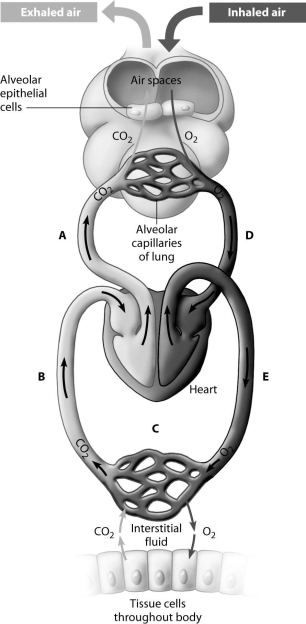A) newt
B) bear
C) frog
D) turtle
Correct Answer

verified
Correct Answer
verified
Multiple Choice
The body structure where gas exchange occurs is called the
A) integumentary surface.
B) exchange network.
C) capillary network.
D) respiratory surface.
Correct Answer

verified
Correct Answer
verified
Multiple Choice
Cigarette smoke can affect the white blood cells that reside in our lungs,whose purpose is to
A) prevent emphysema.
B) enhance oxygen and carbon dioxide exchange.
C) maintain appropriate pH and moisture levels within the lungs.
D) engulf foreign particles.
Correct Answer

verified
Correct Answer
verified
Multiple Choice
Compared to the vital capacity,how much air can lungs actually hold?
A) sometimes less
B) always more
C) sometimes more
D) always less
Correct Answer

verified
Correct Answer
verified
Multiple Choice
The reason animals need a continuous supply of oxygen is to
A) obtain energy from their food.
B) carry out glycolysis.
C) make carbon dioxide.
D) dispose of carbon dioxide.
Correct Answer

verified
Correct Answer
verified
Multiple Choice
High- flying birds are able to obtain enough oxygen even when the air is very thin because
A) they have reduced amounts of hemoglobin in their blood.
B) their heart can increase or decrease in size as altitude changes.
C) their mitochondria are more efficient than those of other vertebrates.
D) they have more efficient lungs than other vertebrates.
Correct Answer

verified
Correct Answer
verified
Multiple Choice
At which point(s) in the figure is blood oxygen- rich? 
A) points A and B
B) points A and D
C) point C only
D) points D and E
Correct Answer

verified
Correct Answer
verified
Multiple Choice
Oxygen is mostly transported through the body in which of the following ways?
A) dissolved in the blood
B) bound to hemoglobin
C) dissolved in red blood cells
D) bound to dissolved iron
Correct Answer

verified
Correct Answer
verified
Multiple Choice
Which of the following is a function of the nasal cavities in humans?
A) warming inhaled air
B) determining O2 content in inhaled air
C) secreting excess carbon dioxide into exhaled air
D) secreting enzymes for digestion
Correct Answer

verified
Correct Answer
verified
Multiple Choice
Most CO2 is transported to the lungs in which of the following ways?
A) as carboxyl
B) attached to hemoglobin or as bicarbonate ions
C) dissolved in the plasma
D) as carbonic anhydrase
Correct Answer

verified
Correct Answer
verified
Multiple Choice
The oxygen- carrying component in red blood cells is
A) hemoglobin.
B) the cell membrane.
C) bicarbonate ions.
D) iron.
Correct Answer

verified
Correct Answer
verified
Multiple Choice
When you hold your breath,which of the following blood gas changes leads initially to the urge to breathe again?
A) falling oxygen concentration
B) rising carbon dioxide concentration
C) falling carbon dioxide concentration
D) rising oxygen concentration
Correct Answer

verified
Correct Answer
verified
Multiple Choice
What part of the human brain contains the primary breathing control center?
A) medulla oblongata
B) neocortex
C) thalamus
D) cerebellum
Correct Answer

verified
Correct Answer
verified
Multiple Choice
Evolutionary movement of aquatic vertebrates to land involved an intermediate individual that
A) is called a "podafish."
B) could fly.
C) had both gills and lungs.
D) evolved a tracheal system of branching internal tubes.
Correct Answer

verified
Correct Answer
verified
Multiple Choice
When you are breathing normally,exhalation results mainly from
A) the contraction of muscles in the chest.
B) the relaxation of the chest muscles and diaphragm.
C) the contraction of the diaphragm.
D) low pressure in the lungs.
Correct Answer

verified
Correct Answer
verified
Multiple Choice
Oxygen moves from blood into the interstitial fluid and then to body cells because
A) it descends down an osmotic gradient,following the movement of water.
B) it diffuses from a higher to a lower pH.
C) it diffuses from a region of higher partial pressure to a region of lower partial pressure.
D) it diffuses from a region of lower partial pressure to a region of higher partial pressure.
Correct Answer

verified
Correct Answer
verified
Multiple Choice
In the countercurrent exchange system of fish gills,
A) blood flow in the gills reverses direction with every heartbeat.
B) blood and water are separated by a thick polysaccharide barrier.
C) blood and water flow in the same direction.
D) blood and water flow in opposite directions.
Correct Answer

verified
Correct Answer
verified
Multiple Choice
Cigarette smoking and secondhand smoke cause cancer due to the
A) toxins in the smoke.
B) immunosuppressive effects they display.
C) resistance they have for products of our immune system.
D) effects they have on our breathing mechanisms.
Correct Answer

verified
Correct Answer
verified
Multiple Choice
Which of the following statements regarding breathing and circulation in insects is false?
A) The tracheal system of insects consists of a series of branching air tubes that extend from the surface to deep inside the body.
B) Insects lose very little water by using a tracheal system to breathe.
C) The circulatory system of insects is not involved in transporting oxygen.
D) Terrestrial animals such as insects spend much more energy than aquatic animals to ventilate their respiratory surfaces.
Correct Answer

verified
Correct Answer
verified
Multiple Choice
Which part of the diagram shows alveoli? 
A) part A
B) part B
C) part C
D) part D
Correct Answer

verified
Correct Answer
verified
Showing 21 - 40 of 46
Related Exams